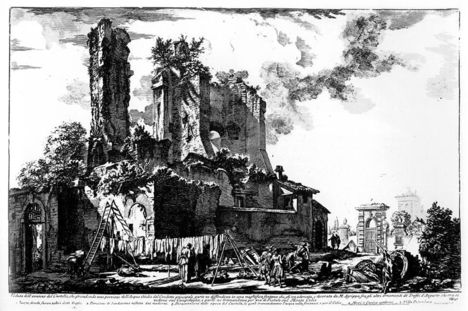In the north of the garden of Piazza Vittorio are the ruins of a great Roman monument, called the Middle Ages "Trophies of Marius".
This name, in fact, appears for the first time in a guide for pilgrims in 1140, the Mirabilia Urbis Romae, and comes from two large marble sculptures that decorated the monument until 1590 (as seen in the engraving of Etienne Duperac) when Pope Sixtus V had them removed and placed on the balustrade of the Capitol, where they remain.
In reality it is a monumental fountain, built in 226 by Emperor Alexander Severus and known in Roman sources as Nymphaeum Divi
Alexandri: is the only survivor of the 15 nymphs monumental mentioned by the ancient sources. To be precise, it is the "water shows Claudia", built at the end of the aqueduct claudio (some arches of it are in Via Turati): a large stage set that graced a functional public work. The same principle we find in some modern fountains, as Fontan Trevi, shows water Virgin, and the Fontanone Acqua Paola on the Janiculum.
The facade had to be magnificent. The upper part was characterized by a large central niche (6.50 meters wide), with perhaps the statues of Alexander Severus and mother Giulia Mamaea; the sides of it two open arches, decorated until 1590 by the statues of the trophies that gave the name to the monument. The whole thing was finished at the top by an attic, decorated with a chariot and other statues, and down from a basin cabinet, dominated by a statue in the center of Ocean lying.
From this basin the water went down, no one knows how, at the bottom of the front, where there were a number of rectangular and semicircular niches (perhaps decorated with statues), from which gushed more water. All water is collected in a large semicircular basin, at street level, where it was possible to draw from it.
For several centuries the magnificent ruins of the "Trophies of Marius" have faced the entrance to Villa Palombara - a great Baroque residence disappearance in the late nineteenth century for the construction of Piazza Vittorio - as you can see in a beautiful engraving by Giovanni Battista Piranesi , 1772, full of charm as all the views of the Venetian artist.
Of the villa, the "Magic Door", located on the back of the Roman monument and the subject of many legends imaginative.
What we see today is just the skeleton of brick fountain, which was to be impressive (25 meters wide, 20 meters high at least) and very rich, completely covered with slabs of marble and decorated with numerous statues. What did he look? The nymph is represented on a gold (gold coin) of Alexander Severus; and in the past many have tried to reconstruct the appearance, beginning with Pirro Ligorio in 1550 or so, when the trophies were still in place. A beautiful reconstruction dates back to 1821, and is the work of Antoine-Martin Garnaud, a fellow of the Villa Medici.


















Kommentáld!